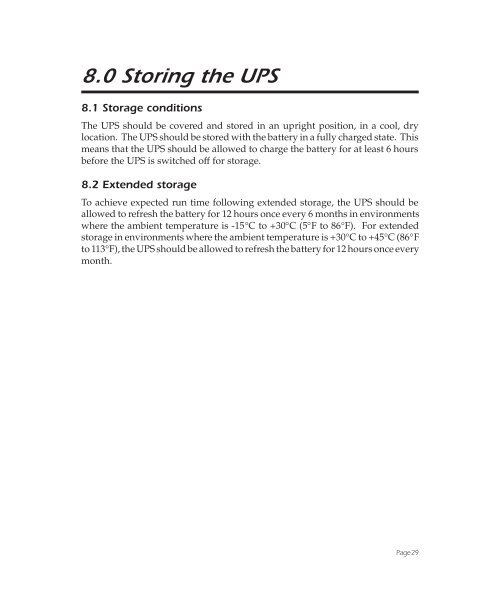Back-UPS® - APC Media
Back-UPS® - APC Media Back-UPS® - APC Media
7.0 Difficulty 7.3 Obtaining Service The troubleshooting chart in section 7.1 covers most of the difficulties that a user may encounter under conditions other than a failure of the UPS itself. For problems not covered in the chart, follow the below listed instructions. ■ See the troubleshooting chart and eliminate the obvious. A tripped UPS circuit breaker is the most common problem encountered and is user resettable once excessive loads are unplugged from the UPS. ■ If the circuit breaker is OK, note your UPS model, serial number and date of purchase. Contact the Customer Service Department at the phone number given on the cover of this manual. ■ Be prepared to provide a description of the problem. A technician will help you solve the problem over the phone if possible, or will give you a Return Material Authorization Number (RMA#). ■ If the UPS is within the warranty period, repairs will be performed free of charge. If it is not within the warranty period, there will be a charge for repair. ■ Pack the UPS in its original packaging. If you no longer have the original shipping materials, ask the technician about obtaining a new set. It is very important that you pack the UPS properly to avoid damage in transit. Never use styrofoam beads for packing because the UPS will settle through beads and become damaged. Damages sustained in transit are not covered under warranty. Enclose a letter in the package with your name, RMA#, address, copy of sales receipt, description of trouble, phone number and check (if necessary). ■ Mark your RMA# on the outside of the package. The factory cannot accept any package without this marking. ■ Return your UPS via insured, prepaid carrier to the address on the rear of this booklet. Page 28
8.0 Storing the UPS 8.1 Storage conditions The UPS should be covered and stored in an upright position, in a cool, dry location. The UPS should be stored with the battery in a fully charged state. This means that the UPS should be allowed to charge the battery for at least 6 hours before the UPS is switched off for storage. 8.2 Extended storage To achieve expected run time following extended storage, the UPS should be allowed to refresh the battery for 12 hours once every 6 months in environments where the ambient temperature is -15°C to +30°C (5°F to 86°F). For extended storage in environments where the ambient temperature is +30°C to +45°C (86°F to 113°F), the UPS should be allowed to refresh the battery for 12 hours once every month. Page 29
- Page 1 and 2: Back-UPS ® Models 250, 400 and 600
- Page 3 and 4: Table of contents 1.0 Introduction.
- Page 5 and 6: 2.0 Safety ! ENGLISH ■ To reduce
- Page 7 and 8: 2.0 Sicherheit ! DEUTSCH ■ Um die
- Page 9 and 10: 3.0 Installation 3.1 Receiving insp
- Page 11 and 12: 3.0 Installation 3.6 Connecting you
- Page 13 and 14: 3.0 Installation 3.6 Connecting you
- Page 15 and 16: 4.0 Principles of operation Below i
- Page 17 and 18: 4.0 Principles of operation 4.2 Loa
- Page 19 and 20: 4.0 Principles of operation 4.8 Ope
- Page 21 and 22: 6.0 UPS monitoring 6.1 Overview A U
- Page 23 and 24: 7.0 Difficulty ENGLISH Caution !
- Page 25 and 26: 7.0 Schwierigkeit DEUTSCH Vorsicht
- Page 27 and 28: 7.0 Difficulty 7.1 Troubleshooting
- Page 29: 7.0 Difficulty 7.2 Replacing the ba
- Page 33 and 34: 10.0 Specifications 9.1 Input Nomin
- Page 35 and 36: Limited Warranty American Power Con
8.0 Storing the UPS<br />
8.1 Storage conditions<br />
The UPS should be covered and stored in an upright position, in a cool, dry<br />
location. The UPS should be stored with the battery in a fully charged state. This<br />
means that the UPS should be allowed to charge the battery for at least 6 hours<br />
before the UPS is switched off for storage.<br />
8.2 Extended storage<br />
To achieve expected run time following extended storage, the UPS should be<br />
allowed to refresh the battery for 12 hours once every 6 months in environments<br />
where the ambient temperature is -15°C to +30°C (5°F to 86°F). For extended<br />
storage in environments where the ambient temperature is +30°C to +45°C (86°F<br />
to 113°F), the UPS should be allowed to refresh the battery for 12 hours once every<br />
month.<br />
Page 29



